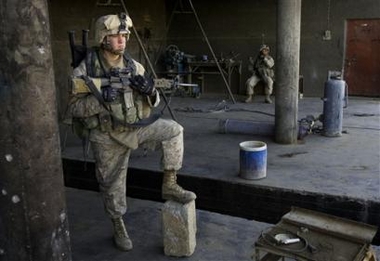|
Sources: US may cancel units' deployment in Iraq
(AP)
Updated: 2005-12-08 08:46
The Pentagon has tentative plans to halt the scheduled deployment of two
brigades to Iraq and instead send in smaller teams to support and train Iraqi
forces in what could be an early step toward an eventual drawdown of U.S.
forces, defense officials said Wednesday.
The proposal comes amid growing pressure from Congress and the public to pull
troops out of Iraq. Details are still under discussion, and it would largely
depend on the military and political conditions there after the parliamentary
elections next week, said the officials.
The two officials, who did not want to be identified because the plans have
not yet been finalized, said a third brigade, initially scheduled to go to
Afghanistan, may also stay home. Defense Secretary Donald H. Rumsfeld is
preparing to announce the plan after the Iraq election next Thursday, if all
goes well, they said.
Pentagon officials have said all along that they hope to reduce U.S. troop
levels, now at about 154,000, as Iraqi security forces become more capable of
defending their own country. A brigade usually numbers around 3,500 troops.
Under the plan, deployment of the 1st Brigade, 1st Infantry Division, based
at Fort Riley, Kan., would be canceled. Instead, for the first time, portions of
the brigade would be divided into 10- or 11-member military transition teams
that would be sent separately into Iraq to work with Iraqi security forces.
Also, some other members of the brigade would go to Iraq to do security duty,
such as guarding high profile targets.

U.S. Marine Lance Cpl. Philip Schrock of
Greenwood, Delaware pauses during a patrol in Karabilah, Iraq, seven miles
from Syria, Wednesday, Dec. 7, 2005. [AP] | The second unit that would not deploy to Iraq is the 2nd Brigade, 1st Armored
Division, which is currently in Kuwait and is usually based in Germany. Under
the plan, up to two-thirds of the brigade would return to Germany, while the
rest would stay in Kuwait, prepared to respond to any emergency in Iraq.
The 4th Brigade, 10th Mountain Division, based at Fort Polk, La., would not
go to Afghanistan.
NATO has been gradually expanding across Afghanistan, assuming responsibility
for security from the U.S.-led coalition. The NATO-led force has about 12,000
soldiers from 36 nations and is responsible for security in Kabul as well as
northern and western regions of the country. A separate, 20,000-strong U.S.-led
force is in the east and south hunting Taliban and al-Qaida fighters.
The new deployment plan would not dramatically reduce the number U.S. forces
in Iraq but instead would set the stage for a gradual troop reduction, allowing
the military to stop or delay other unit deployments planned for 2006-2008.
President Bush has refused to set a withdrawal timetable, and the
administration has consistently said U.S. troops will remain as long as needed.
The administration, with Vice President Dick Cheney at the forefront, has
strongly criticized a call last week by Rep. John Murtha (news, bio, voting
record), D-Pa., for a U.S. withdrawal within six months.
A month ago, the Pentagon announced that more than 92,000 troops would be in
the next rotation of U.S. forces in Iraq. Rumsfeld said the 92,000 should not be
taken as the final troop level and said the exact size would not be decided
until after the election. The usual troop level this year has been about
138,000, but the total peaked at about 160,000 this fall because of concerns
about heightened violence during the elections.
|